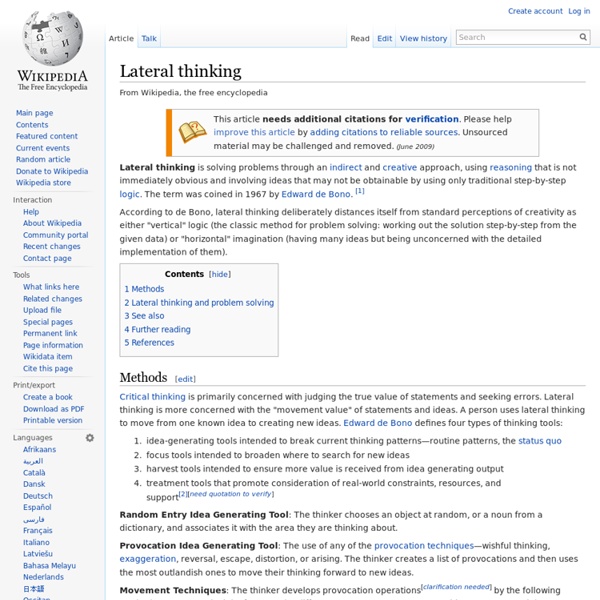Ways not to kill classroom creativity
Eleven Classroom Creativity Killers Marvin Bartel - © 2001, updated Apri 3, 2013 ". . creativity scores had been steadily rising. . .until 1990. Since then, creativity scores have consistently inched downward." from: Bronson, Po & Merryman, Ashley.
Creative problem solving
Creative problem-solving, a type of problem solving, is the mental process of searching for a new and novel creative solution to a problem, a solution which is novel, original and not obvious. Creative solution types[edit] The creative solution[edit]
And How Students Can Respond
In a continued effort to bring you the very best, most expert and diverse education content anywhere, in addition to the ideas of Grant Wiggins, Bena Kallick, Art Costa, and Nathan Jurgenson among others, TeachThought is also proud to share the ideas of Dr. Judy Willis, neuroscientist, Ph.D., and middle school teacher. By Dr. Judy Willis Although the brain is an amazing organ, it’s not equipped to process the billions of bits of information that bombard it every second.
The 10 habits of highly creative people, applied to creative companies « Marketing Babylon
The book Creativity : Flow and the Psychology of Discovery and Invention (previously titled: Creativity: The Work and Lives of 91 Eminent People) contains an exploration of the common personality traits of creative people. The traits are articulated as a series of ten paradoxes. Before listing them, he writes: Of all human activities, creativity comes closest to providing the fulfillment we all hope to get in our lives.
Feeling Words
Emotional Intelligence | Emotional Literacy Feeling Words / Emotion WordsWords Describing Feelings and Emotions * = Newly created words Thanks to all the people who have contributed new words. I am sorry but it has proven impractical for me to name them all.
Go Climb a Tree
Dear Joel, Micah and Brenna, You love to climb trees. Literal ones with tangling branches that seem to reach the atmosphere. When you do, you show courage.
Test Your Creativity: 5 Classic Creative Challenges
Fascinated by how brains and creativity work, we frequently share new research on the 99U twitter feed, showing how everything from drinking alcohol, to taking vacations, to moving your eyes from side to side can make you more creative. What’s particularly interesting, however, is that most of these studies rely on just a small group of core creativity tests – and you don’t need any special lab equipment to take them. Below, we’ve collected five of the most commonly used creativity challenges for your self-testing pleasure. While creativity “testing” is far from an exact science, trying your mettle at these challenges could yield insight into when, where, and how you’re most creative. Or maybe it’ll just be fun. 1.
Therapy Dogs International
“Tail Waggin’ Tutors” Children Reading to Dogs The main objective of this program is to provide a relaxed and “dog-friendly” atmosphere, which allows students to practice the skill of reading. Many of the children chosen for this program have difficulties reading and as a result have developed self-esteem issues.
What Is Intelligence? Just a Byproduct of Cooperation.
What's the Latest Development? By developing computer simulations of neural networks that evolved over 50,000 generations, scientists at Trinity University have concluded that intelligence is an evolutionary byproduct of social teamwork. Each neural network, or 'brain', took part in two social dilemmas in which "two players must choose between cooperation and defection during repeated rounds. Upon completion of either game, each 'brain' produced 'offspring' with other 'brains' that made more advantageous choices during the games. ... After 50,000 generations, the model showed that as cooperation increased, so did the intelligence of the programmed brains."
Potential Benefits of Animal Assisted Therapy
THE POTENTIAL BENEFITS of ANIMAL ASSISTED THERAPY FOR CHILDREN WITH SPECIAL NEEDS Dawn Oakley OTR/L and Gail Bardin, OTR/L According to journalist Odean Cusack, “Anyone who has ever owned a pet will readily verify the benefits of associating with furred, feathered, or finned friends. Animals are fun to be with and comforting to hold. Their antics inspire humor and a sense of carefreeness, a return to childhood with its buoyant spirits. Caring for pets encourages nurturance, responsibility, and adherence to a daily schedule.
Berkeley researchers map out how our brains categorize the things we see
Researchers at the University of California, Berkeley have created a map showing how and where the brain categorizes the actions and objects we see every day. The study began by taking five human subjects and placing them in an MRI machine while they each watched two hours of movie trailers. Each of the trailers had been analyzed to track the different objects and types of motion present — a leaf holding still, or a butterfly flying, for example. The MRI then allowed the researchers to track the blood flow in the brain to see what areas were being stimulated during the screenings. They then used regression analysis — a statistical technique that is able to determine relationships between different events — to determine how the approximately 30,000 locations in the brain they were tracking matched up to the 1,700 types of objects and actions in the movie trailers.
Critical Thinking On The Web
Top Ten Argument Mapping Tutorials. Six online tutorials in argument mapping, a core requirement for advanced critical thinking.The Skeptic's Dictionary - over 400 definitions and essays. The Fallacy Files by Gary Curtis. Best website on fallacies.



